The norm of dry food for puppies: calculation table, frequency rate and feeding rules
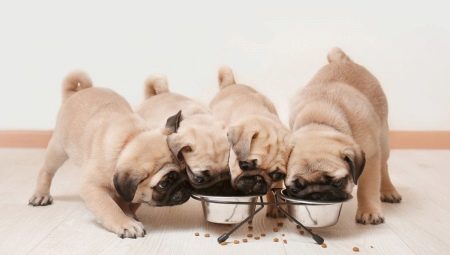
When a puppy appears in the house, many questions immediately arise regarding caring for him, the main of which is feeding. Dog owners in this matter are divided into two camps: some are categorically against dry food, while others, on the contrary, believe that it contains all the necessary nutrients for a pet. Supporters of ready-made meals should familiarize themselves with the features of this food and learn how to calculate the daily allowance for a pet.
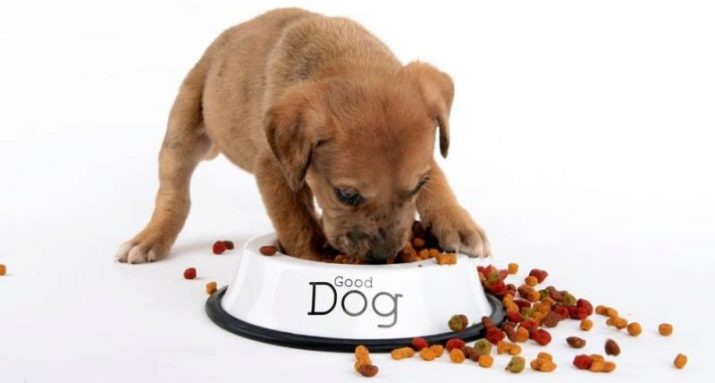
How to calculate the daily rate?
At first, this question torments many good owners, because you don't want to feed your pet or keep him constantly hungry. But before you start calculating the daily allowance for your pet, you should familiarize yourself with the features of using dry food.
The benefits of dry food are clear.
- Convenience for the owner. There is no need to cook daily for the animal and calculate the rate of each dish.
- Good nutrition. Most dry foods contain all the nutrients that dogs need, which save the owner from additional costs and visits to the veterinarian.
- Diversity. If your pet needs special food, then it can be found among the variety of foods.
- Saving money and time. When using dry food, it becomes possible to save money on food, because the portion of food will clearly differ in both quantity and price in comparison with the food prepared by the owner.

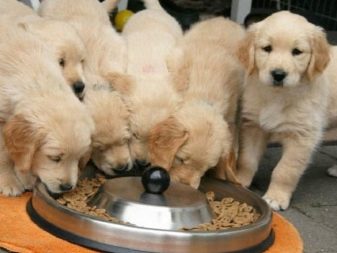
Many dry food breeders worry that their pet's diet is monotonous.In this regard, sometimes they "dilute" the pet's menu with homemade food, relying that they do it well for the dog, but often this is not the case. This feeding has its consequences.
- If you mix feed with meat, then there will be an excess of protein. This affects the kidneys, as a result of which the pet may develop renal failure and allergies.
- If you mix food with fish, then you cannot avoid a large amount of phosphorus in the body. In this case, the reproductive system of the animal will suffer, primarily the urinary system: stones are formed that adversely affect the liver and intestines. Hemoglobin in the blood also decreases, which leads to a weakening of the immune system and subsequently small hemorrhages. Bones begin to weaken, leaving the dog prone to multiple fractures.
- If you mix food with porridge, you get an excess of carbohydrates. This leads to excess weight, due to which other problems arise, such as obesity, heart problems, excessive appetite.
- The mixed type of feeding also badly affects the stomach, so gastritis is inevitable.
If there is a desire to somehow diversify the puppy's menu, then it is better to switch to separate meals. You can safely give both meat and fish, vegetables, fruits, it just should be in reasonable quantities and not be mixed with dry food.
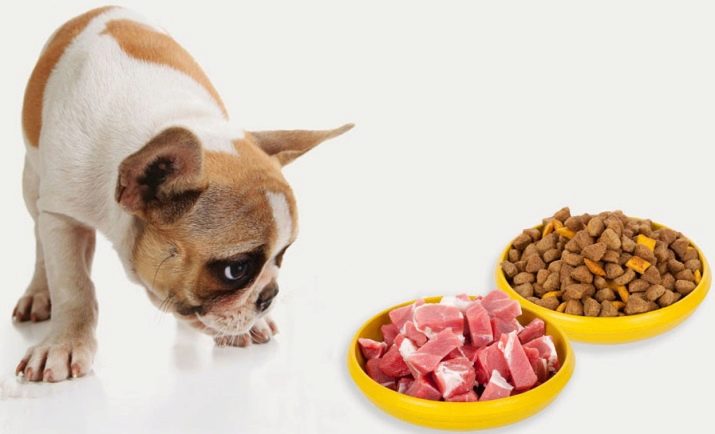
When using this or that type of food, the daily rate should be calculated. It is not difficult to do this with natural products, because each of them has its own energy value. Calculating the daily value of dry food is even easier, because it is divided into classes, for each of which this indicator is also known.
There are four classes of dry food
- Economy Energy value - 260-300 Kcal. The composition of such a feed contains the cheapest foodstuffs, or rather, leftover meat. This class of food will help to save your budget, but the dog's body will be "like", because it contains virtually no vitamins, minerals and carbohydrates.
- Premium. Energy value 310-350 Kcal. Many pedigree dogs are allergic, so it is recommended to take at least premium food. The composition contains the necessary vitamins in small quantities, the amount of proteins is significantly increased.
- Super premium. Energy value - 350-450 Kcal. It is considered a complete, balanced diet. This class includes proteins, carbohydrates, fiber, oils and fats, as well as a vitamin and mineral complex. Thanks to this combination, the pet will not only receive all the necessary substances, but also feel great.
- Holistic. Energy value - 350-450 Kcal. Made exclusively from natural products. In terms of its ingredients, such food is comparable to human food.
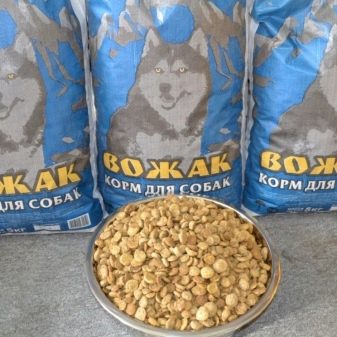
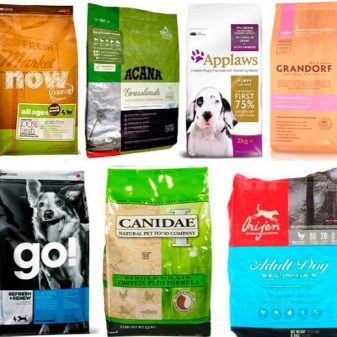
In order to determine the daily feed for a puppy, you need to know its weight and calculate the daily activity so that calories are restored in a balanced way. The table below shows the daily serving size for a moderately active pet. If the pet is less active, then the rate should be slightly reduced, if more active, then, on the contrary, increase. (Decrease and increase is in the range of +/- 15 g).
Daily feeding rate depending on the weight of the pet:
| Dog weight (kg) | Number of grams per day (g) |
|---|---|
| 2 | 58 |
| 5 | 88 |
| 10 | 162 |
| 20 | 270 |
| 30 | 380 |
| 40 | 470 |
| 50 | 550 |
| 60 | 650 |


If you cannot determine the class of dry food that the pet consumes, then you should pay attention to the packaging. Usually, it indicates the energy value and the content of useful nutrients per 100 grams. It is imperative to familiarize yourself with the packaging, because the grammar can sometimes differ from the given table. It is important to know the amount of Kcal that a puppy needs to receive per day, and already from this you can build on when determining the number and weight of portions.
Number of Kcal for a puppy per day:
| Age | Kcal per 1 kg |
|---|---|
| up to 4 weeks | 218 |
| from one month to 3 months | 263 |
| from 3 to 4 months | 200 |
| from 4 to 8 months | 134 |
| from 8 to 12 months | 100 |
After determining the daily intake of nutrients for a pet, you should figure out how many times a day you need to feed it.
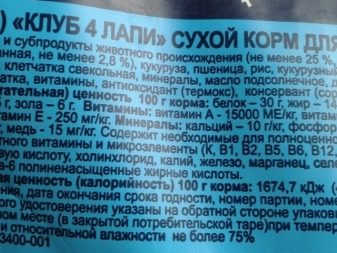
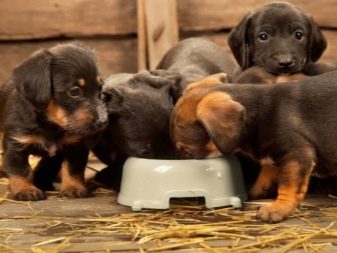
How many times a day to give?
You need to calculate the number of feedings per day depending on the breed and age of the dog. And it is better to give food to the pet at a certain time and a certain number of times, then the pet will get used to the diet, and there will be no digestive problems. The time intervals between feedings should be left approximately equal and have your own regimen in mind, so that the owner or the one who will feed the dog has the opportunity to do it regularly. It is also worth noting that puppies need to be fed more times per day than adult dogs.
Number of puppy feedings:
| Pet age (months) | Number of feedings per day |
|---|---|
| Up to 2 months | 6 times |
| 2-3 months | Five times |
| 4-6 months | 4 times |
| 6-12 months | 3 times |
| From a year and older | 2 times |
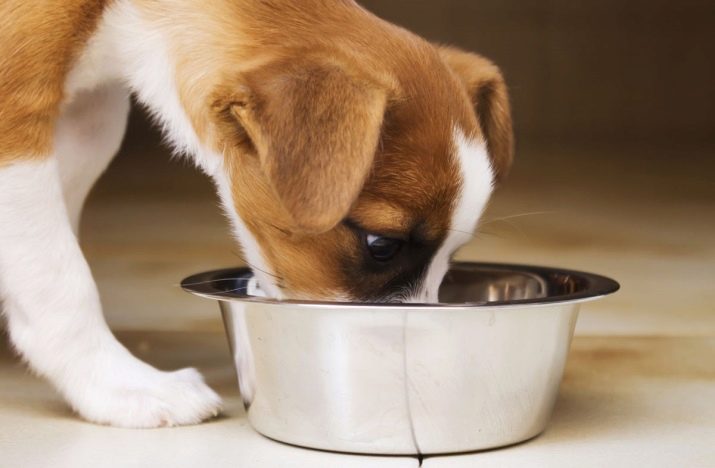
We must not forget that the regimen for the pet is a very important component, therefore it is not recommended to constantly change the number of feedings. It is advisable to immediately calculate the correct dosage of feed per day. After reading the data on the package, calculating the required amount of Kcal per day for the pet and understanding how many times it will be necessary to feed the puppy, you should proceed to calculating the amount of portions. This indicator per day will depend on the age, weight and activity of the pet.
The table below shows the possible daily feed intake for moderately active puppies. Depending on the feed, the gramme may vary compared to the table.
Daily feed for puppies (in grams):
| Puppy weight (kg) | 2 | 3 | 4 | 5 | 6 | 7 | 8 | 10 | 12 | 14 | 15 | 16 | 18 | 20 |
|---|---|---|---|---|---|---|---|---|---|---|---|---|---|---|
| Puppy age (months) | ||||||||||||||
| from 2 months | 49 | 64 | 79 | 93 | 103 | 113 | 124 | 146 | 163 | 182 | 192 | 200 | 215 | 231 |
| from 3 months | 55 | 72 | 88 | 105 | 110 | 132 | 145 | 171 | 192 | 214 | 226 | 236 | 257 | 277 |
| from 4 months | 56 | 75 | 92 | 110 | 125 | 131 | 153 | 183 | 205 | 230 | 242 | 254 | 276 | 298 |
| from 5 months | 56 | 75 | 93 | 110 | 126 | 142 | 156 | 185 | 208 | 234 | 246 | 259 | 282 | 306 |
| from 6 months | 48 | 69 | 84 | 100 | 125 | 141 | 155 | 184 | 207 | 233 | 247 | 258 | 282 | 306 |
| from 7 months | 41 | 62 | 76 | 90 | 113 | 127 | 140 | 167 | 188 | 217 | 229 | 240 | 263 | 285 |
| from 8 months | 40 | 55 | 67 | 80 | 101 | 114 | 126 | 147 | 169 | 202 | 213 | 224 | 245 | 266 |
| from 9 months | 40 | 54 | 67 | 79 | 90 | 101 | 112 | 133 | 151 | 185 | 195 | 205 | 224 | 242 |
| from 10 months | 40 | 54 | 66 | 78 | 89 | 100 | 111 | 132 | 149 | 168 | 176 | 186 | 203 | 221 |
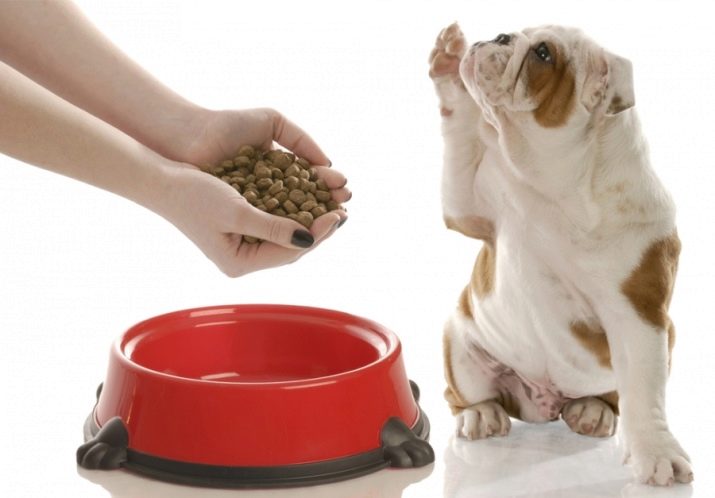
If the pet is too active, for example: a sports dog or a service dog, then the calculation of the feed rate changes slightly. It is necessary to add another 1/3 to the standard portion, while it is not necessary to increase or decrease the number of feedings. Otherwise, the puppy will be overfeeding or, conversely, there will be a lack of nutrients, and to prevent this from happening, it is advisable to familiarize yourself with the feeding rules.
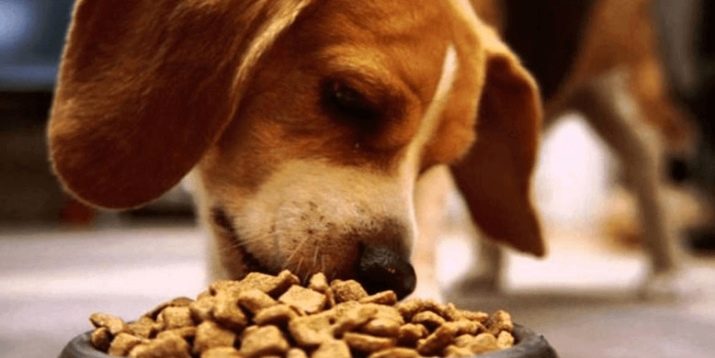
How to feed properly?
In order not to overfeed the puppy, there are a few rules to follow.
- It is necessary to feed at the same time so that the body gets used to the daily routine. It will also help to avoid stomach enlargement, and subsequently obesity. With this mode, it will be easier to train the puppy to the toilet, and the pet should be walked after each meal in 15 minutes.
- If the puppy has been eating a certain food before you, then you should not immediately transfer it to another - give it time to adapt. The first week should be fed with the products to which he is accustomed. Then gradually add ¼ of the new feed to the serving (increase the amount of the new feed in relation to the old one during the week). And only after that you can completely switch to another diet. It is advisable to add new feed in a separate bowl.
- If the puppy has never eaten dry food, then in the first days of feeding, you can soak it a little. Not all pets can eat dry food with pleasure, therefore, in order for the body to calmly accept the food and not have problems with digestion, a couple of minutes before feeding, you can fill dry granules with warm water so that they have time to absorb water. If in this form the puppy did not finish the food, then it is better to put it in the refrigerator, because it spoils when soaked.
- There should always be clean drinking water. Due to the abundant consumption of dry food, a lack of fluid may appear, which will lead to metabolic disorders, and against this background, a number of diseases arise. Make sure the water bowl is always full of sufficient quantity.
- If the pet has not finished eating or touched the bowl at all, then remove the food.The next feed will be on schedule - never feed earlier or in large quantities. But if refusals to eat continue, then you should revise the feeding schedule or contact your veterinarian - perhaps the pet is simply sick.
- It is undesirable to mix different types of feed. This can be bad for your pet.
- If the puppy has not yet fully switched to dry food, then it is best to observe him while eating. Usually 10 minutes is enough for him to eat. But if during this time all the food disappears and the bowl is licked, then this amount is not enough - you need to slightly increase the dosage. If there is food left in the bowl, then this is too much and it is necessary to reduce the amount of food.
In order for your pet to always be cheerful and healthy, you cannot ignore the rules, and at first you should observe the preferences and reactions when eating.
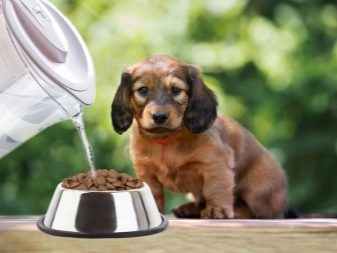
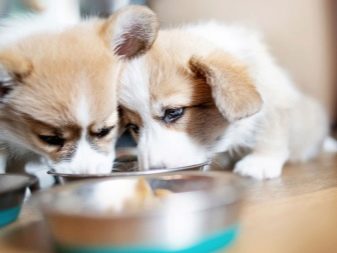
What to do if you don't eat enough?
The fact that the pet does not gorge itself can be understood by the quickly eaten portion and the licked bowl or by the condition of the dog shortly before the next meal: it can be lazy, exhausted and wait for feeding. In this case, there may be different solutions:
- first, you should once again familiarize yourself with the packaging of the feed: each variety has its own dosage, based on age and weight category;
- if the information on the package did not help, then you can find another feed, maybe this is the point;
- if it's not about the food, then the feeding schedule and daily allowance should be revised, perhaps the dog is leading a more active life than was originally calculated.
But if the problems still cannot be solved (there are difficulties in choosing food or it is not possible to calculate the daily rate), then it is better to contact a specialist, because it is necessary to accustom the pet to proper nutrition from the very beginning.

For information on how to feed a puppy correctly, see the next video.






































